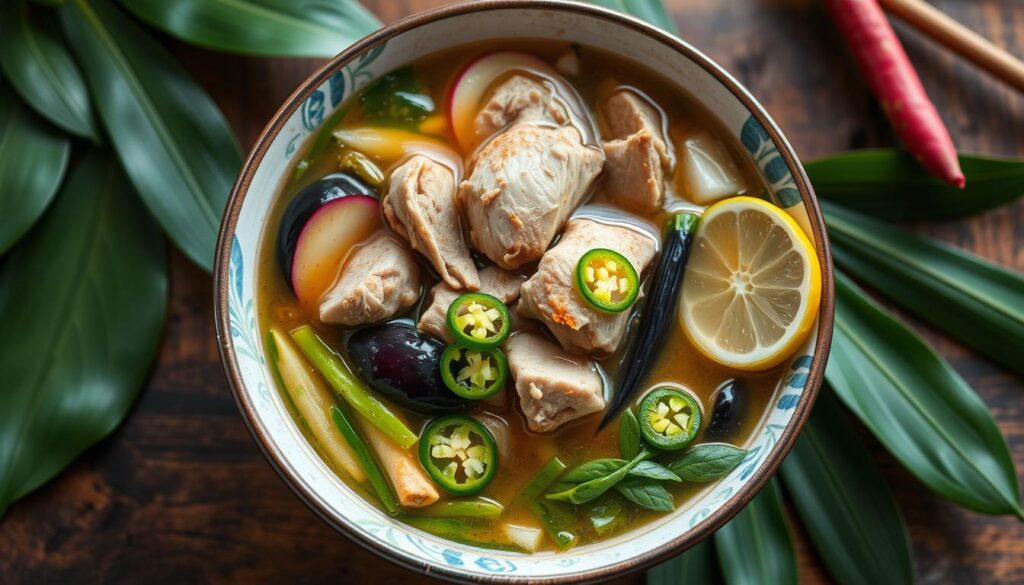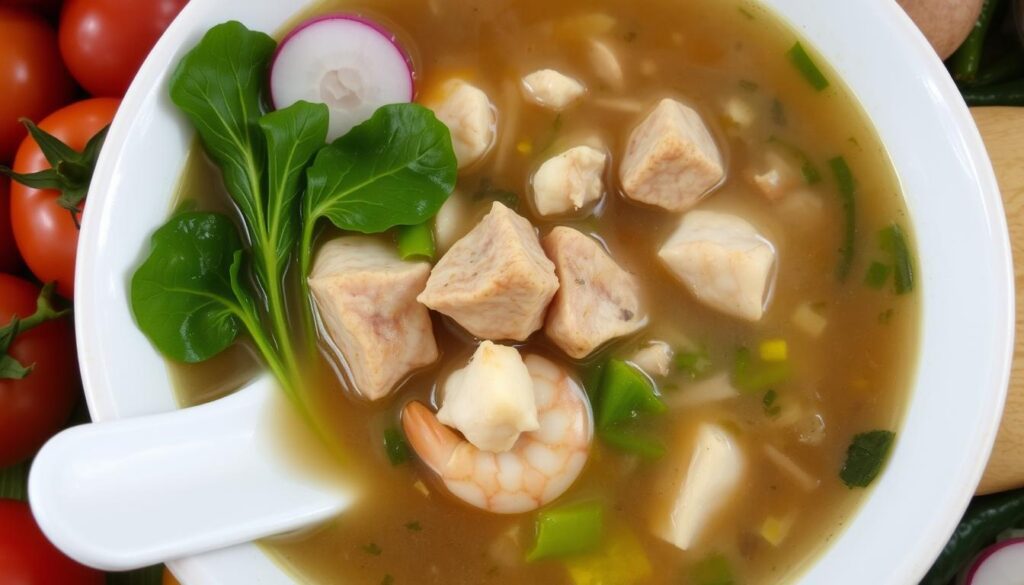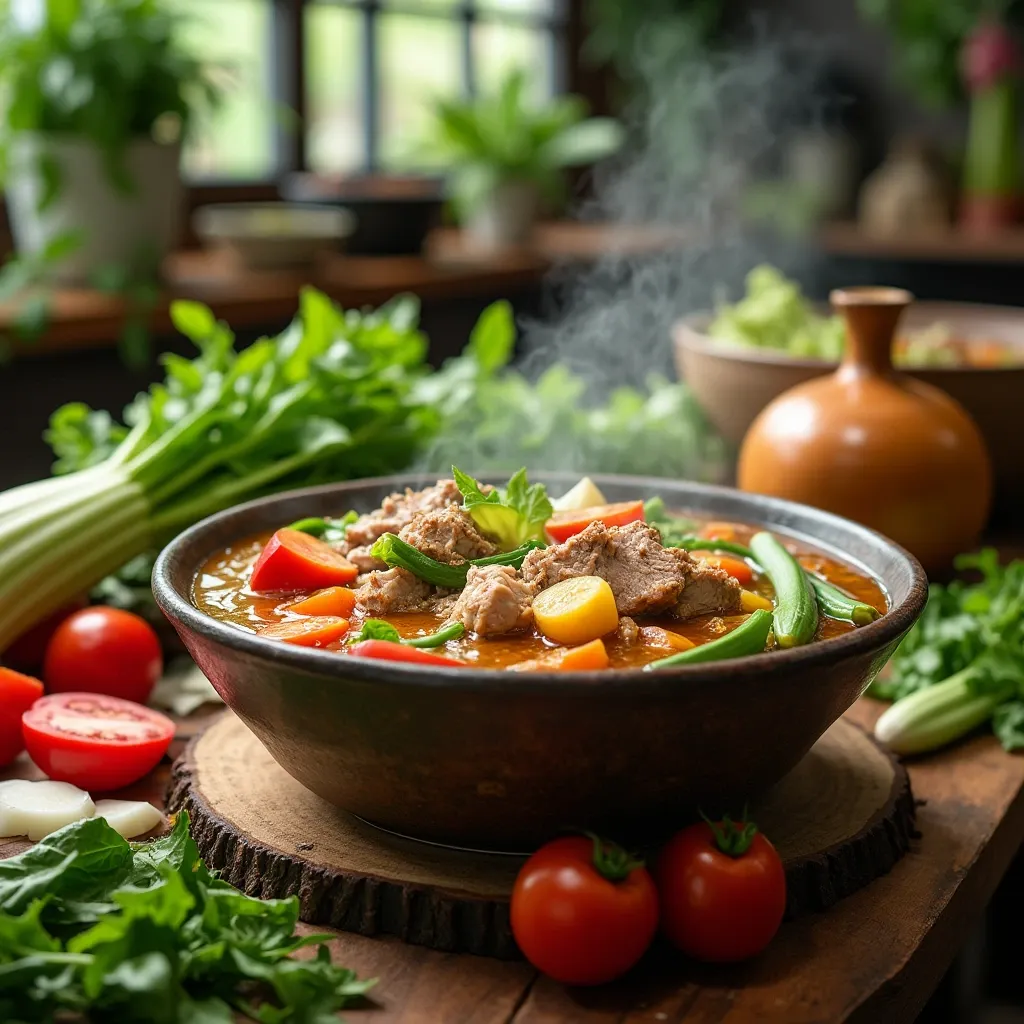Sinigang is a favorite Filipino sour soup loved by many. It was named the best vegetable soup by TasteAtlas in 2021. This dish is a big part of Filipino culture, with many variations like sinigang na hipon and sinigang mix inasal na manok.

The core of sinigang is its tangy broth, made with young tamarind. But sinigang is more than just broth. It’s a mix of ingredients that come together to make a delicious meal.
Understanding the Cultural Significance of Sinigang
Sinigang is a favorite dish in the Philippines, loved by many. It comes from the Tagalog word “sigang,” which means “to stew.” In 2021, TasteAtlas named it the best vegetable soup globally, showing its worldwide fame.
Historical Origins of the Dish
The story of sinigang goes back to the Philippines’ rich food history. It has changed over time, becoming a comfort food for many. Its mix of flavors and ingredients makes it a hit in Filipino cuisine.
Regional Variations Across Philippines
Every province in the Philippines has its own sinigang recipe. From Ilocos in the north to Mindanao in the south, each version is special. They use local ingredients and flavors, showing the country’s food diversity.
Cultural Impact and Modern Recognition
Sinigang is more than just a meal; it’s a symbol of Filipino pride. Being named the world’s best soup in 2021 boosted its cultural value. It has sparked a new interest in Filipino cuisine.

Essential Ingredients for Traditional Sinigang
Sinigang is a famous Filipino sour soup known for its complex flavors. It uses special ingredients that blend together perfectly. These ingredients include proteins, vegetables, and souring agents.
Pork, like belly or buto-buto, is a key protein in sinigang. Vegetables like water spinach, string beans, eggplant, and tomatoes add depth. The sour broth is made with young tamarind, but guava, green mango, and calamansi can also be used.
Some places use taro roots instead of potatoes. They also add snake beans and more water spinach. Fish sauce is added to make the flavor even better.
The right mix of ingredients makes sinigang special. The tender pork and tangy broth are key to its unforgettable taste.
What is sinigang made of?
Sinigang is a favorite Filipino soup or stew known for its sour taste. It can be made with different sinigang meat options like pork, beef, chicken, fish, or shrimp. The sinigang vegetables used in the broth include tomatoes, onions, daikon radish, eggplant, string beans, and water spinach.
The sinigang broth is key, made with water, tamarind concentrate, and fish sauce. Some recipes add ginger, garlic, and citric acid crystals for more sourness.
Primary Meat Options
Sinigang can use many proteins, making it flexible for everyone. Common sinigang meat options are pork belly, spare ribs, and beef. Chicken, fish, and shrimp are also great choices.
Core Vegetable Components
The sinigang vegetables add to the dish’s flavor. They include tomatoes, onions, daikon radish, eggplant, string beans, and water spinach. Together, they make a balanced and healthy soup.
Broth Base Elements
The broth is the heart of sinigang, made with water, tamarind concentrate, and fish sauce. Some recipes add ginger, garlic, or citric acid crystals for extra sourness in the sinigang broth.
The Art of Souring Agents in Sinigang
Sinigang, a beloved Filipino dish, relies on the balance of flavors. Souring agents are key to this balance. Young tamarind is the main souring agent, giving the soup its tangy taste.
But there are other souring agents too. Each one adds its own flavor to the dish. This variety makes sinigang special across the Philippines.
Guava, bilimbi (kamias), green mangoes, pineapple, and cotton fruit (santol) are some of these agents. They change the taste of sinigang based on where you are.
Learning to use souring agents well is important. It makes sinigang taste great. The mix of sour and savory flavors is what makes it special.
Traditional Preparation Methods
Making a real sinigang, the favorite Filipino sour soup, needs a good grasp of old ways. The key is getting the tamarind flavors right. This step is what makes the soup sour.
Extracting Tamarind Flavors
To start, boil fresh young tamarind in water for 40 minutes to an hour. This long boil lets the tamarind’s tartness mix well with the broth. After, strain the liquid carefully to get a bright, tasty tamarind soup base.
Cooking Time and Temperature Control
Next, add the meat, like pork, beef, or seafood, to the tamarind broth. Cook it until it’s tender, which can take 45 to 90 minutes. It’s important to keep the cooking time and temperature right. This makes sure the meat is just right and the flavors blend well.
Sequential Addition of Ingredients
The last step is adding vegetables one by one. Start with the root vegetables, then add leafy greens like water spinach last. This way, each veggie adds its own taste and texture to the soup.
Popular Meat Variations in Sinigang
Sinigang is a favorite Filipino sour soup with many protein options. Sinigang na baboy, or pork sinigang, is a top pick. It uses tender pork belly or juicy spare ribs.
Seafood fans love sinigang na hipon, or shrimp sinigang. It combines tangy flavors with juicy shrimp.
Sinampalukang manok, or chicken sinigang, is another favorite. It’s a hearty dish with chicken and robust flavors.
Every protein in sinigang adds its own taste. It also changes how long it cooks and the method used. But the core of sinigang stays the same. It’s a mix of sour, savory, and sweet that makes it uniquely Filipino.
Essential Vegetables and Their Cooking Order
Sinigang is a favorite Filipino sour soup. It’s all about the mix of flavors and textures. The way we add vegetables is key to getting it just right.
Root Vegetables and Their Timing
First, we add root veggies like daikon radish and eggplants. They need more time to get soft and soak up the broth’s flavor. This step is important for the dish’s base.
Leafy Greens and Final Additions
Next, we add string beans and okra, which cook a bit faster. Then, we add the leafy greens like water spinach. We start with the stems and finish with the leaves. This way, each part is cooked right and stays fresh.
Adding veggies in the right order is key. It makes sure each part is cooked perfectly. This way, sinigang tastes great and feels right.
The Role of Seasonings and Aromatics
In making a real sinigang, seasonings and aromatics are key. Fish sauce, or patis, adds a salty taste and depth. Sliced garlic, ginger, and onions create a fragrant base.
Black pepper adds a touch of heat and spice. This mix of flavors is what makes sinigang special. It’s loved by many in the Philippines.
Using a sinigang seasoning mix or making it from scratch, these ingredients are vital. They turn a simple soup into a flavorful dish. It shows the beauty of Filipino cooking.

